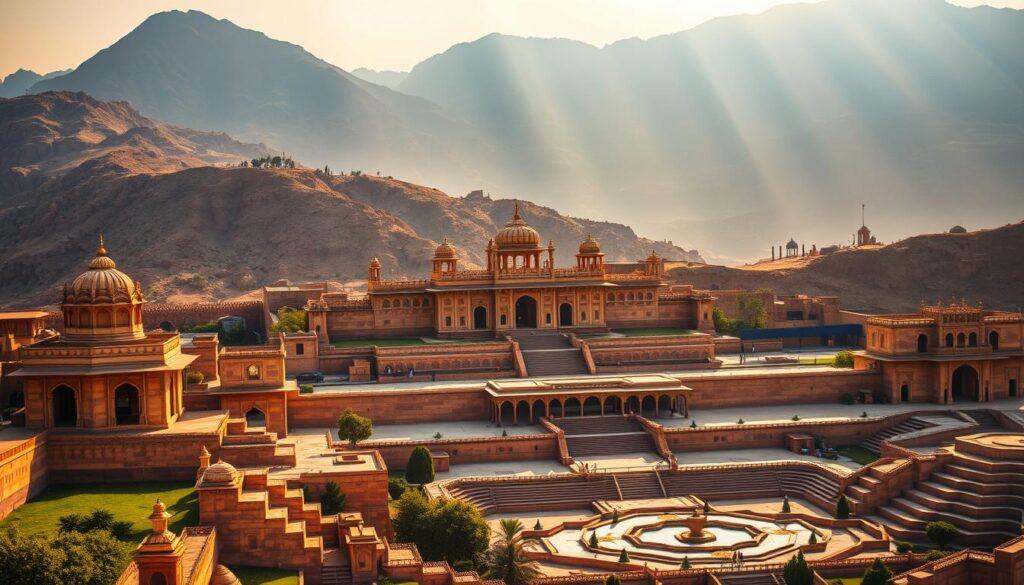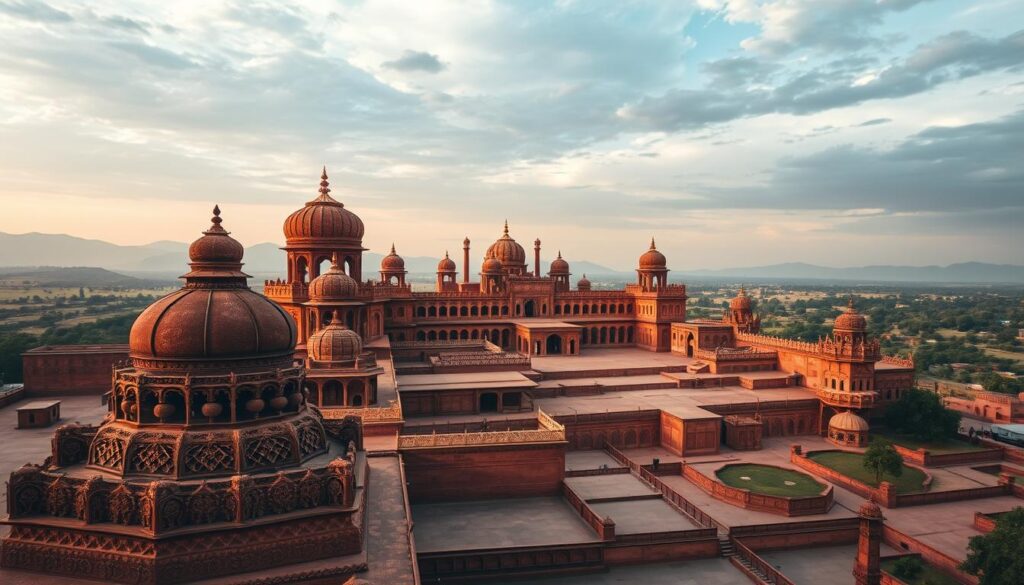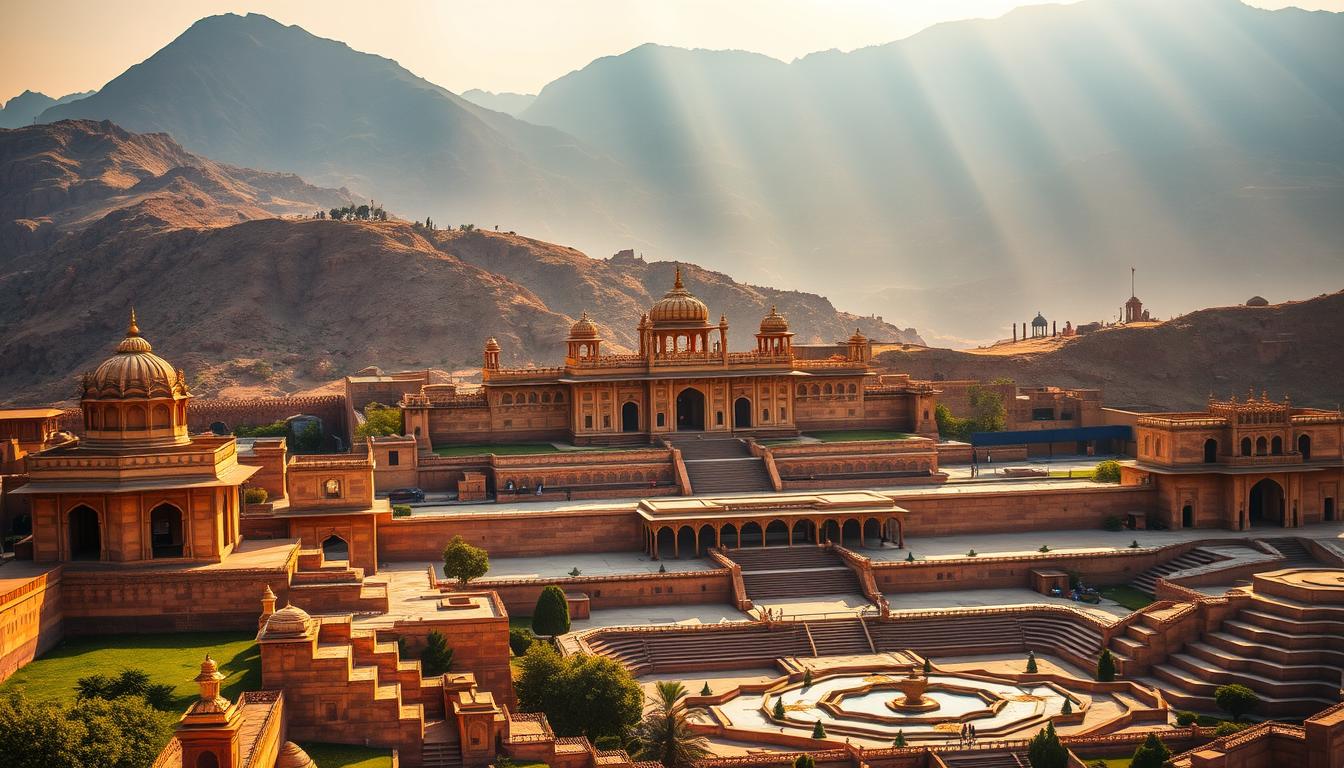Why did Akbar build Fatehpur Sikri in that location: Learn about the intriguing reasons that led Akbar to build the iconic Fatehpur Sikri in its distinctive location.
We explore why Emperor Akbar built Fatehpur Sikri in 1571. It’s in the Agra District of Uttar Pradesh, India. The city’s huge buildings, made mostly of red sandstone, show Akbar’s dream for a united Mughal Empire.

The city was built to honor Sheikh Salim Chishti, a Sufi saint. Its design mixes Hindu, Muslim, and Jain styles. This shows Akbar’s belief in a society where everyone can live together peacefully.
Key Takeaways
- The construction of Fatehpur Sikri was driven by Akbar’s desire to unify the Mughal Empire.
- The city’s architecture reflects a blend of different cultural influences.
- Fatehpur Sikri was founded in 1571 by Emperor Akbar.
- The city’s location was chosen to honor Sheikh Salim Chishti.
- The use of red sandstone in the city’s construction adds to its historical significance.
The Historical Context of Akbar’s Reign

The Mughal Empire under Akbar’s rule was a mix of cultures and politics. Akbar’s interactions with different religious and cultural groups shaped his vision for the empire.
Akbar’s Vision for a Unified Mughal Empire
Akbar wanted a unified Mughal Empire, welcoming all cultures and religions. His talks with Sufi saints, like Sheikh Salim Chishti, greatly influenced his policies. In 1568, Akbar first met Shaikh Salim Chishti and asked for his prayers for a son. Later, he sent the pregnant Rajput queen Mariam Zamani to Sikri.
Related Posts: Where is Sheikh Salim Chishti’s tomb located within Fatehpur Sikri?
The Political and Cultural Landscape of 16th Century India
The 16th century in India was full of cultural and political diversity. Many regional influences shaped the area’s architecture and culture. Akbar’s rule was a mix of Mughal and local traditions, showing his dream of a unified empire.
Why Did Akbar Build Fatehpur Sikri in That Location?
Akbar picked Fatehpur Sikri for his capital city for spiritual and strategic reasons. We’ll dive into these reasons to grasp his decision.
The Spiritual Connection: Sheikh Salim Chishti’s Prophecy
Akbar built a religious compound for Sheikh Salim Chishti. This was after the saint predicted the birth of his son, Jahangir. This prophecy was key in Akbar’s choice of Fatehpur Sikri. The site’s spiritual value was a big pull for Akbar, who greatly respected the Sufi saint.

Strategic and Geographical Advantages of the Ridge Location
Fatehpur Sikri’s ridge location had many benefits. It offered natural defense against invaders and a beautiful landscape for the city’s design. The site’s red sandstone was also used in the city’s construction.
Choosing this location, Akbar made a city that was both spiritually meaningful and strategically smart.
Architectural and Cultural Significance of Fatehpur Sikri
Fatehpur Sikri’s architecture shows a mix of cultures, thanks to Akbar’s dream of unity. It combines Hindu, Muslim, and Jain styles. This mix shows Akbar’s open-minded approach to society.
Availability of Red Sandstone and Other Natural Resources
The city was built with red sandstone and local materials. This choice made Fatehpur Sikri unique. It also showed Akbar’s support for local skills and materials.
Design as a Reflection of Akbar’s Din-i-Ilahi and Religious Tolerance
The city’s design mirrors Akbar’s Din-i-Ilahi faith. It values tolerance and understanding among religions. Fatehpur Sikri’s architecture shows Akbar’s dream of a society where all faiths live together peacefully.
Conclusion: The Legacy and Eventual Abandonment
Fatehpur Sikri was Akbar’s dream for a united Mughal Empire. It was chosen for spiritual, strategic, and cultural reasons. The city’s start was guided by a prophecy and its location’s benefits.
Even though Akbar left in 1585 for Punjab and it was fully abandoned by 1610, Fatehpur Sikri is still a treasure. It stands as a symbol of India’s rich history and diversity. Today, it draws visitors, showing the Mughal Empire’s greatness and cultural wins.
FAQ
Why did Akbar build Fatehpur Sikri?
Akbar built Fatehpur Sikri to honor Sheikh Salim Chishti. He wanted to create a unified Mughal Empire.
What was the significance of Sheikh Salim Chishti’s prophecy?
Sheikh Salim Chishti’s prophecy about Akbar’s son, Jahangir, was key. It influenced Akbar’s decision to build Fatehpur Sikri.
What geographical advantages did the ridge location offer?
The ridge location provided natural defense and a beautiful view. It was perfect for the city.
What influenced the architecture of Fatehpur Sikri?
Akbar’s Din-i-Ilahi faith and the use of red sandstone shaped Fatehpur Sikri’s architecture. Natural resources also played a role.
What is the cultural significance of Fatehpur Sikri?
Fatehpur Sikri shows a time of peace and cultural exchange. It reflects Akbar’s dream of a harmonious society.
Why is Fatehpur Sikri considered an important cultural and architectural landmark?
Fatehpur Sikri is significant because of its mix of Hindu, Muslim, and Jain styles. It shows Akbar’s vision for unity and tolerance.

My name is Radha Sharma and I live in Agra. I have started this first blog of my life Agrafast.in to make my future in blogging by watching videos of many big bloggers through the internet for a long time.

